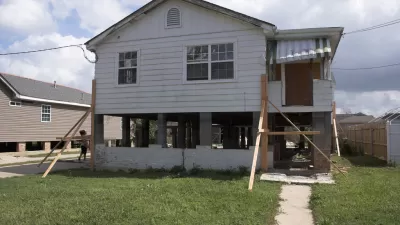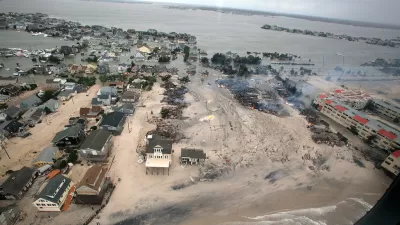In the wake of Superstorm Sandy, a new task force convened by New York's Mayor Michael R. Bloomberg and City Council speaker Christine C. Quinn will look into potential changes to the city's building code, with recommendations due next summer.
The Building Resiliency Task Force, to be chaired by Russell Unger, executive director of the Urban Green Council, is being charged with taking "an in-depth look at how to prepare city buildings for future storms and infrastructure failures." As Unger told reporter Mireya Navarro, "the new group would need to address both direct impacts from the storm, like structure collapse and flooding, and secondary ones, like power losses from utility failures."
"Some of the potential measures [to be considered] are relatively simple, like keeping sandbags handy and installing floodgates at building entrances. Others are more complicated, like relocating critical equipment like boilers above ground level or encasing them in watertight enclosures and rebuilding houses on concrete piles."
"What does not seem to be getting consideration, at least for now, is banning development altogether in the city’s flood zones, humble or affluent," says Navarro.
“'This is not a viable policy option in New York City, and to be honest, nor is it in any other major coastal city I’ve been working,' said Jeroen Aerts, a water risk expert from the Free University in Amsterdam who has been hired by the mayor’s office to assess flood protections. 'The stakes of developers and general economic activities in the waterfront are too high.'”
FULL STORY: After Storm, Dry Floors Prove Value of Exceeding City Code

Trump Administration Could Effectively End Housing Voucher Program
Federal officials are eyeing major cuts to the Section 8 program that helps millions of low-income households pay rent.

Planetizen Federal Action Tracker
A weekly monitor of how Trump’s orders and actions are impacting planners and planning in America.

Ken Jennings Launches Transit Web Series
The Jeopardy champ wants you to ride public transit.

Tackling Soil Contamination With Nature-Based Solutions
Los Angeles County residents and experts are turning to nature-based methods like bioremediation to address long-standing and fire-exacerbated soil contamination without resorting to costly and disruptive removal.

Rebuilding Smarter: How LA County Is Guiding Fire-Ravaged Communities Toward Resilience
Los Angeles County is leading a coordinated effort to help fire-impacted communities rebuild with resilience by providing recovery resources, promoting fire-wise design, and aligning reconstruction with broader sustainability and climate goals.

When Borders Blur: Regional Collaboration in Action
As regional challenges outgrow city boundaries, “When Borders Blur” explores how cross-jurisdictional collaboration can drive smarter, more resilient urban planning, sharing real-world lessons from thriving partnerships across North America.
Urban Design for Planners 1: Software Tools
This six-course series explores essential urban design concepts using open source software and equips planners with the tools they need to participate fully in the urban design process.
Planning for Universal Design
Learn the tools for implementing Universal Design in planning regulations.
Ada County Highway District
Clanton & Associates, Inc.
Jessamine County Fiscal Court
Institute for Housing and Urban Development Studies (IHS)
City of Grandview
Harvard GSD Executive Education
Toledo-Lucas County Plan Commissions
Salt Lake City
NYU Wagner Graduate School of Public Service




























